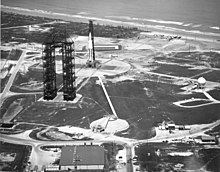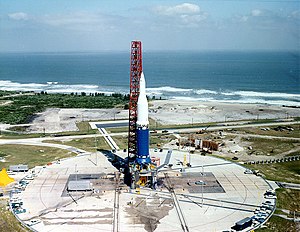Cape Canaveral Launch Complex 34
 | |||||||||||
 | |||||||||||
| Launch site | Cape Canaveral Air Force Station | ||||||||||
|---|---|---|---|---|---|---|---|---|---|---|---|
| Location | 28.52182°N 80.561258°W | ||||||||||
| Short name | LC-34 | ||||||||||
| Operator | US Air Force | ||||||||||
| Total launches | 7 | ||||||||||
| Launch pad(s) | 1 | ||||||||||
| Orbital inclination range | 28° - 57° | ||||||||||
| |||||||||||
Cape Canaveral Air Force Station Launch Complex 34 (LC-34) is a launch site at Merritt Island, Cape Canaveral, Florida. LC-34 and its twin to the north, LC-37, were used by NASA as part of the Apollo Program, to launch Saturn I and IB rockets.
Notably, it was the site of the Apollo 1 fire, which claimed the lives of astronauts Gus Grissom, Ed White, and Roger Chaffee, on January 27, 1967.
History
Construction
Work began on LC-34 in 1960, and it was formally dedicated on June 5, 1961. The complex consisted of a launch platform, umbilical tower, mobile service tower, fueling facilities, and a blockhouse. Two steel flame deflectors were mounted on rails to allow placement beneath the launch platform. The service tower was likewise mounted on rails, and it was towed to a position 185 meters west of the pad before launch. At 95 meters high, it was the tallest structure at LC-34.
The blockhouse, located 320 meters from the pad, was modeled after the domed reinforced concrete structure at LC-20. During a launch, it could accommodate 130 people as well test and instrumentation equipment. Periscopes afforded views outside of the windowless facility.
Saturn I series
LC-34 saw its first launch on October 27, 1961. The first Saturn I, Block I, mission SA-1, lofted a dummy upper stage on a suborbital trajectory into the Atlantic. The subsequent three Saturn I launches took place at LC-34, ending with SA-4 on March 28, 1963. The six ensuing Saturn I, Block II launches were conducted at LC-37.
Saturn IB series
LC-34 was extensively modified to support Saturn IB launches, which began in February 1966. New anchor points were built to fasten the service structure in place during high winds. Access arms on the umbilical tower were rebuilt to match the larger rocket. At the 67-meter level, the swing arm was outfitted with a white room to permit access to the command module at the top of a rocket.
Two Saturn IBs (AS-201 and AS-202) were successfully launched from LC-34 before the fire brought Apollo activities at the spaceport to an abrupt halt. After the fire, extinguishing equipment were installed at the top of the umbilical tower, and a slide wire was set up to provide astronauts a quick escape in the event of an emergency.
The first manned Apollo launch – Apollo 7 on October 11, 1968 – was the last time LC-34 was used. NASA considered reactivating both LC-34 and LC-37 for the Apollo Applications Program, but instead LC-39B was modified to launch Saturn IBs.
Launch Complex 34 today


After the decommissioning of LC-34, the umbilical tower and service structure were razed, leaving only the launch platform standing at the center of the pad. It serves as a memorial to the crew of Apollo 1. A dedicatory plaque affixed to the structure bears the inscription:
LAUNCH COMPLEX 34
Friday, 27 January 1967
1831 Hours
Dedicated to the living memory of the crew of the Apollo 1:
U.S.A.F. Lt. Colonel Virgil I. Grissom
U.S.A.F. Lt. Colonel Edward H. White, II
U.S.N. Lt. Commander Roger B. Chaffee
They gave their lives in service to their country in the ongoing exploration of humankind's final frontier. Remember them not for how they died but for those ideals for which they lived.
Another plaque reads:
IN MEMORY OF THOSE WHO MADE THE ULTIMATE SACRIFICE SO OTHERS COULD REACH FOR THE STARS
AD ASTRA PER ASPERA
(A ROUGH ROAD LEADS TO THE STARS)
GOD SPEED TO THE CREW OF APOLLO 1
Also surviving at the LC-34 site are the two flame deflectors and the blockhouse.
Launch history
This is a complete list of all launches made from LC-34.

| Date | Time (GMT) |
Launch Vehicle | Mission | Payload | Remarks |
|---|---|---|---|---|---|
| October 27, 1961 | 15:06 | Saturn I | SA-1 | (none) | First use of LC-34, First flight of Saturn I. |
| April 25, 1962 | 14:00 | Saturn I | SA-2 | Highwater | Self-destruct detonated after completion of mission to test effects of water at high altitudes on communications. |
| November 16, 1962 | 17:45 | Saturn I | SA-3 | Highwater | Self-destruct detonated after completion of mission to test effects of water at high altitudes on communications. |
| March 28, 1963 | 20:11 | Saturn I | SA-4 | (none) | |
| February 26, 1966 | 15:06 | Saturn IB | AS-201 | Apollo CSM | First flight of Saturn IB and Apollo Spacecraft |
| August 25, 1966 | 17:15 | Saturn IB | AS-202 | Apollo CSM | |
| October 11, 1968 | 15:02 | Saturn IB | Apollo 7 | Manned Apollo CSM | First manned Apollo flight, last use of LC-34 |
See also
- List of spaceflights by year
- List of Merritt Island launch sites
- Merritt Island
- Cape Canaveral Air Force Station
- Project Apollo
- Saturn I
- Saturn IB
